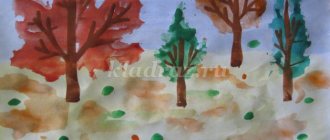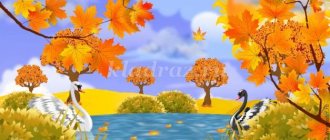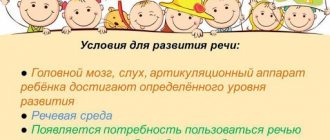Open lesson in the preparatory group of the preschool educational institution “Golden Autumn”
- October 27, 2016
Fast distance online competitions
Competition “Methodological piggy bank of a teacher”
Open lesson “Golden Autumn” in the senior preparatory group of the kindergarten. The lesson is aimed at developing cognitive and aesthetic experience, artistic taste, and a poetic ear through material related to one of the seasons - autumn.
Program content
The child and the world around him.
Natural surroundings. Environmental education
- Observe natural phenomena. Help establish cause-and-effect relationships between natural phenomena. Deepen and concretize ideas about the living conditions of plants and animals.
- Form ideas about wintering and migratory birds.
- Strengthen the ability to find and recognize wintering birds: sparrow, magpie, tit, bullfinch, etc.
- To form an aesthetic attitude towards the surrounding world. Encourage children to reflect their impressions in applications.
- Carry out vocabulary work, expanding and clarifying knowledge about the environment.
Fiction
- Continue to develop an interest in fiction.
- Help listen carefully and interestedly to stories and poems.
- Using various techniques and specially organized pedagogical situations, promote the formation of an emotional attitude towards what is perceived.
Artistic and aesthetic education
- Application
- Strengthen the ability to create images.
- Continue to develop the skills of careful and careful handling of materials.
Preliminary work:
- Looking at paintings about autumn.
- Learning poems.
Material:
- Paintings.
- Fruits, flowers.
- Portrait of autumn.
- Scissors, glue, colored paper, brushes, rags, clothescloths.
- "Tea lounge"
Progress of the lesson
Educator:
“A sad time, the charm of the eyes... Your farewell beauty is pleasant to me. I love the lush nature of withering, Forests dressed in crimson and gold. In their canopy there is noise and the first frosts and distant gray winter thunderstorms.
Now we'll talk about autumn. After what time of year does autumn come?
Children: After summer.
Educator: Name all the months of autumn.
Children: September, October, November.
Pugachev's song "Summer" is playing.
Educator: We can do something so that summer doesn’t end.
Children: You can't.
Child 1: There are 4 seasons in nature: winter, summer, spring, autumn. 12 months. Each season lasts 3 months. Everything in nature is in order: 3 months - winter, 3 months - spring, 3 months - summer, 3 months - autumn. And again all over again, because the sun heats less, not like in the summer. The days have become shorter, the sun shines less.
Educator: All seasons are good, but autumn is especially good.
Examination of paintings depicting periods of autumn.
Educator: Autumn, a festive and colorful time of year, has always pleased poets and artists. Look at the paintings, in which the artists each spoke in their own way about their love for autumn. A true artist is able to feel and understand the mood of nature - joyful or sad, jubilant or calm.
Here, look at how the artist spoke about his love for autumn in his painting.
Examination of the painting “Silence”, art. Podlaski.
Child 1: Autumn has come, the autumn wind howled and tore the yellow leaves from the trees. Leaves flew, swirled and fell to the ground in a multi-colored crimson carpet. Look, there are thin birch trees on the edge of the lake. Near the tallest birch tree there is a table and two benches. Nobody here.
Child 2: And just yesterday my grandfather and I sat on them and admired the lake, picked flowers and picked mushrooms in that green forest over there. Autumn will pass, winter will come, spring, then summer, and grandpa and I will come here again.
Examination of the painting “Evening Bells”, art. Levitan.
Educator: Now pay attention to this picture. Whose bold colors and brushes are these? Which artist brought a miracle? This is Levitan's painting "Evening Bells".
Child: There is indescribable beauty in this picture. All the trees are decorated with gold. Birch trees with long braids, wearing elegant yellow sundresses, look into the quiet river. Beautiful girlfriends are fashionable. What do you hear?
Music sounds: Bell ringing.
Child:
A blue haze looks into the eyes of the log shacks, Over the bluebell meadow the Cathedral rings its bells. The ringing of bells and roundabout, And the ringing of bells. And each bell into the soul Until new joys and strength, Your meadows ring no louder than the Bells of Your Rus'...”
Educator: Indeed, over there in the distance beyond the Kupala River you can see the bell towers of the white monastery. The bell rings at the service and calls people. How to get there? You'll have to swim across the river. The water in the river is clean, transparent, crystal - and everything is reflected in it: the trees, the banks, and the sky.
This is how artists confessed their love for autumn, and this is how Russian poets talked about their love.
Child 1 reads Pleshcheev’s poem “Autumn.”
Child 2 reads Chusovitin’s poem “Autumn Leaf.”
Educator: Many artists fell in love with autumn and painted autumn landscapes, and others painted autumn still lifes.
Child 3:
If you see in the picture Marigolds in a basket Or an aster in crystal Or a chrysanthemum in a vase Or a rose on the table Or all the objects at once - Know that this is a still life.
Child 4:
If you see in the picture a vase of fruit on the table, or a pear or a plum, or a peach to the side. Maybe you saw bunches of grapes here now Or all the fruits at once - Know that this is a still life.
Educator: Here is a living still life, and here is a still life in a painting. You look at a still life, everything on it looks like it’s alive. Ripe grapes, berry after berry. The melon is huge, ripe, yellow, oval. I really want to try it.
September flew by quickly, and October is coming to an end.
Soon white snowstorms will lift the snow from the ground. The cranes are flying away, flying away, flying away. You can’t hear the cuckoo in the grove and the birdhouse is empty. The stork flaps its wings - It flies away, it flies away.
What happens to the birds in the fall?
Children: They fly away to the south.
Educator: Many birds feed on insects, but there are none. So they fly south.
Child 1:
The leaves fly away in the fall, the grasses dry up in the swamps, the birds gather in flocks and are ready to fly away.
Child 2:
And saying goodbye to their native places, With golden birches and willows, They circle for a long time over the forests, Over steep river cliffs.
Child 3:
Come back, birds, in the spring, When the forest is clothed with greenery, Every bush and every tree will rustle with young leaves.
Educator: Autumn is flying away, the birds are flying away, but red autumn will remain in our memory for a long time. And as a memory of autumn, we will leave her portrait in sunny autumn colors.
In an autumn wreath of colorful leaves, in an autumn wreath of fragrant fruits. Let's finish the portrait and decorate our cafe with it, where currant juice with farewell autumn leaves awaits us.
Author: Ekaterina Viktorovna Pershina, teacher of the Children's Preschool Educational Institution Central District of Children's Education - Kindergarten No. 46, Apatity, Murmansk Region.
Lesson summary “Golden Autumn”
Theme of the week “Golden Autumn” Familiarization with the world around us 1. Children should know: *names of the autumn months, the main signs of autumn;
*changes that occur in autumn in the flora and fauna; *what people do in the fall, how they dress; *distinctive features of early and late autumn. 2. Children should be able to: *generalize, compare signs, specify concepts, highlight the main signs of autumn, analyze phenomena, use existing knowledge about autumn in solving problems, performing exercises, assignments; *be interested in the phenomena of living and inanimate nature; *be able to establish cause-and-effect relationships (changes in living and inanimate nature and changes in external conditions: the gradual extinction of plant life is caused by cold weather; the departure of birds is associated with the disappearance of insects and the freezing of water bodies). 3. Game “Before-between-for”. Consolidating ideas about the seasons, an exercise in time orientation. (What time of year will come before autumn, after autumn, between summer and winter (autumn), between winter and summer (spring), etc.) 4. Game “Echo”. Practice the formation of complex words using the method of adding stems. Leaves are falling. - This is leaf fall. The stars are falling. - This is a meteor shower. The water is falling. - This is a waterfall. Stones are falling. - It's a rockfall. It's snowing. - It's snowing. 5. Game “I’ll start, and you finish” People in the fall are dressed (in what?) -...; schoolchildren go with their briefcases (where?) - ...; the leaves on the trees have become (what?) - ...; flowers in the flower beds (what did they do?) - ...; birds fly away (where?) - ...; animals do for the winter (what?) - ...; people collect in forests, gardens, fields and vegetable gardens (what?) - ... . 6. Compose a descriptive story on the topic “What clothes do we wear in the fall” according to plan: a) Why do we dress warmer in the fall than in the summer? b) What do we wear on our feet (in dry weather and in rain)? c) What do we put on the body? d) What do we wear on our heads, necks, hands? d) When do we take an umbrella with us? Speech development 1. Dictionary. Nouns: autumn, cloud, rain, weather, leaf fall, dirt, earth, dampness, jacket, raincoat, boots, hat, gloves, sweater, umbrella, September, October, November. Verbs: pour, blow, step on, wither, drizzle. To wilt, frown, sprinkle. Adjectives: Cold, wet, gloomy, autumnal, oblique, dull, cloudy. Golden (autumn), gray (days), chilly, pouring, drizzling. Adverbs: Wet, damp, stormy, cloudy. 2. Game “Say otherwise.” An exercise in selecting synonyms. A dull time - dull, sad, dreary, gloomy, sad. The sky is gray - dark, cold, cloudy. Trees are naked - naked, naked (without leaves). The flowers dried up and withered. 3. Game “Say the opposite”. Search for antonyms. Early autumn - late autumn. A happy day is a sad day. Sunny day - cloudy day. White cloud - black cloud. 4.Form high-quality adjectives. Autumn - autumn; November – November; sun - sunny; September – September; rain - rainy; cold - cold; October - … ; cloud - … ; warm - … . 5. Select actions (what does it do?). Rain - dripping, pouring, drizzling, coming... . The wind blows, blows, blows, breaks.... 6. Game “One - many”. Formation of the plural of verbs, nouns and adjectives (say according to the example). An autumn day has come - autumn days have come; there is a yellow leaf on the tree - there are yellow leaves on the trees; a dark cloud is floating - dark clouds are floating; there is a big tree - there are big trees; it's cold raining - it's raining coldly; a strong wind blows - heavy rains blow; a warm jacket is hanging - warm jackets are hanging; a flock of birds is flying - flocks of birds are flying. Learning to read and write Topic “Vowel sound O, letter O” 1. Determine by ear the place of the sound in words: wasps, catfish, popsicle, mustache (there is no O sound). 2.Remember the difference between a sound and a letter. We pronounce sounds and write letters. 3.Analysis of the letter O. What object does this letter resemble? There is no angle in this letter, that is why it is round. Look at the wheel - And you will see the letter O. 4. Write this letter in the air. 5. Riddle It grows on the bushes in the garden, The smell is sweet, like honey, But often the tears flow Those who tear with their hands... (Roses) You can tell the child a little about the rose. (The rose is called the queen of flowers. It is the most fragrant and the most beautiful.) *How can you say about a rose? The child himself gives definitions and synonyms. For example: beautiful, wonderful, charming, magnificent, etc. Then comes the analysis of this word, division into syllables (orally). Let's draw a diagram: 6. Phonetic game “Who is more attentive?” Didactic task. Develop phonemic awareness; to develop the ability to hear the sound O in words. The child, after listening to the tongue twister: That’s why Sovronya was given a snout, so that she could dig the earth, counts and names words with the sound O. Remember and name as many words as possible. Option. The child can be offered words with the sound O in different positions - not only at the beginning of the word. (For example: windows, boots, cinema, etc.) 7. Game “Catch the sound “O”” (clap your hands) *Isolating sound: -from the sound series: o, a, u, i, o, i, a, o, a, y, o, i, e, etc.; -from the syllabic series: at, from, op, un, ik, ok, etc.; -from a number of words: fence, cabbage, vegetable, tail, old man, cat, rooster, glass, toad, beetle, taxi, cake, etc. FEMP 1. Reinforce the composition of the number 6, graphically depict the number 6. 2. Develop logical thinking and spatial imagination. 3.Practice in solving problems, identifying parts in a problem. 4. Game exercises: “Whoever knows, let him continue” (goal: practice counting within 10 in forward and reverse order), “Name the neighbors of the number.” 5. Consolidating the composition of the number 6 (3da3; 5da1; 4da2; 2da4; 1 and 1, da1, da1, da1; da1). 6.Working with a number segment. 7.Work on the sheet “Continue the pattern.” (For example, a circle, square, triangle, circle, square is drawn on a sheet of paper. The child must then continue the drawing itself to the end of the line)


